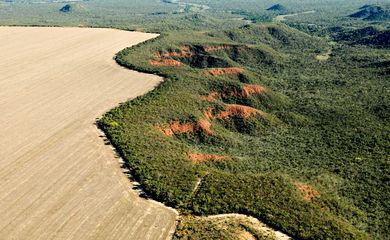Deforestation in the cerrado shrinks after five years on the rise

The official rate of deforestation in the cerrado, Brazil’s second largest biome, fell for the first time in the last five years, the National Institute for Space Research (INPE) reported Wednesday (Nov. 6). The suppression of native vegetation amounted to 8,174 km² from August 2023 to July 2024.

The survey is run through the Cerrado Deforestation Satellite Monitoring Project (Prodes Cerrado), in which detection reaches an accuracy of 10m over clear-cutting and deforestation stemming from progressive degradation, like fires. Monitoring takes place from August of one year to July of the following year, between the biome’s driest seasons. The result marks a reversal of an expansion in cerrado deforestation tracked for five consecutive years, since 2018–2019.
Around 76 percent of the deforestation is still concentrated in four states—Maranhão, Tocantins, Piauí, and Bahia, the states that make up the acronym Matopiba, the cerrado’s main agricultural frontier today. In these states, however, the project saw a significant drop comparing 2023–2024 with the immediately preceding period. In Bahia, for example, the shrinkage stood at 63.3 percent, followed by 15.1 percent in Maranhão, 10.1 percent in Piauí, and 9.6 percent in Tocantins.
The reduction in cerrado deforestation, the federal government reported, means that 41.8 million tons of carbon dioxide were no longer emitted into the atmosphere.
“The data we’ve just seen here, showing a drop in deforestation in the cerrado, which for many would be impossible, is gaining more and more momentum—and also has the support of the private sector,” Minister for the Environment and Climate Change Marina Silva said during the announcement of the results to the press at the Planalto presidential palace.
Nonprofits, however, argue that forest loss levels are still through the roof. “Despite the downward trend confirmed by Prodes, the destruction figures are still high in the time series. Most of the deforestation in the cerrado takes place on private properties, which makes it clear that there is an urgent need for the productive sector to be more involved. The economic pressure on this biome, mainly due to the expansion of commodity-related activities, coupled with environmental legislation that is still fragile and ineffective, makes the situation even more critical,” Daniel Silva, WWF-Brasil’s conservation specialist, warned.
A pact with the states
At the event on Wednesday, the environment minister also inked a pact between the federal government and the state governments of Maranhão, Tocantins, Piauí, and Bahia. The agreement aims to strengthen joint efforts to prevent and combat deforestation and fires in the region, in a joint initiative underway since March.
The partnership, the ministry reported, “seeks to increase collective action to identify and apply sanctions to illegal deforestation on rural properties in the region, and to improve rules to ensure transparency, information sharing, and strategy development for the conservation of water and forest assets of native vegetation in the several ecosystems of the cerrado in Matopiba.”


